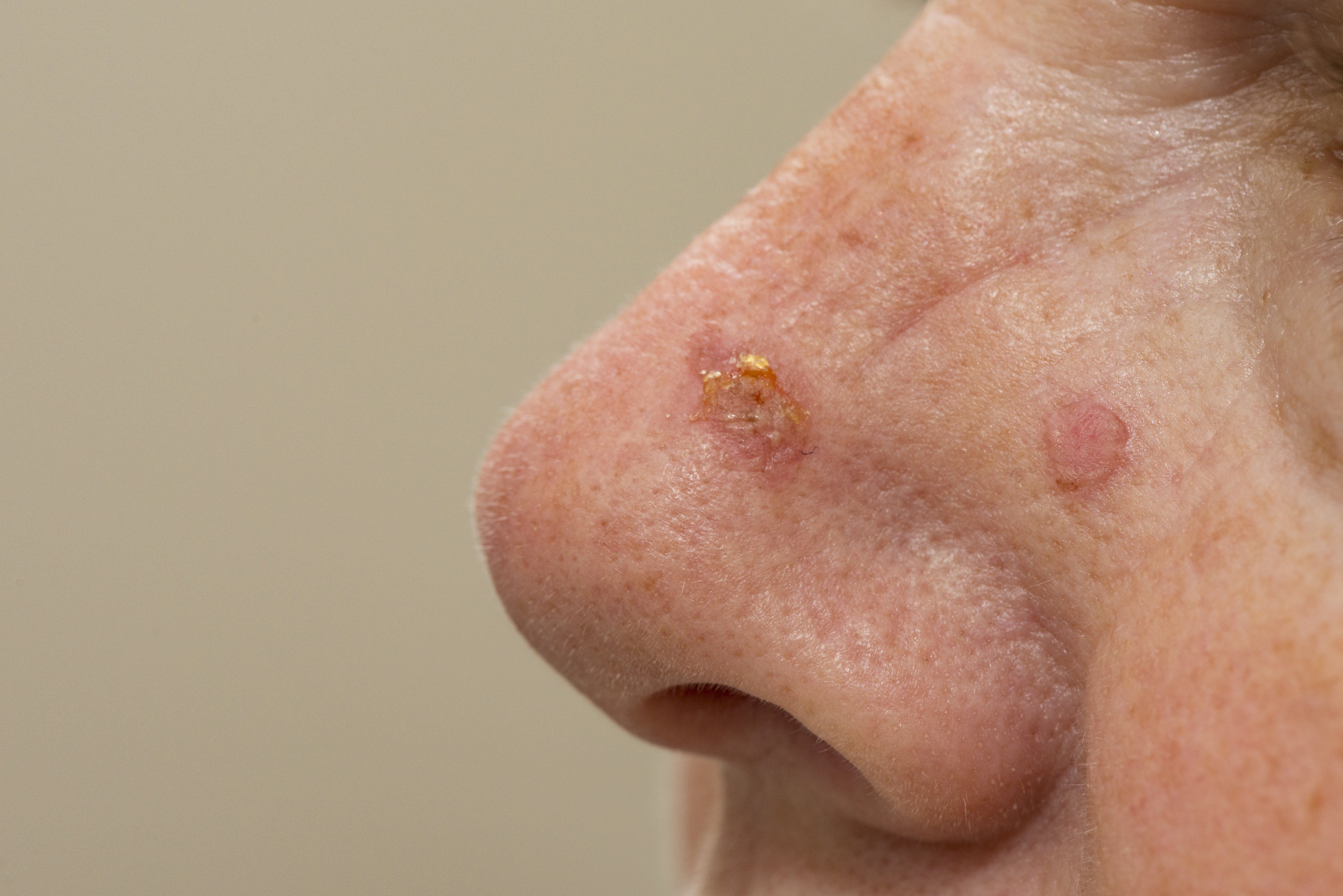- Acne
- Actinic Keratosis
- Aesthetics
- Alopecia
- Atopic Dermatitis
- Buy-and-Bill
- COVID-19
- Case-Based Roundtable
- Chronic Hand Eczema
- Chronic Spontaneous Urticaria
- Drug Watch
- Eczema
- General Dermatology
- Hidradenitis Suppurativa
- Melasma
- NP and PA
- Pediatric Dermatology
- Pigmentary Disorders
- Practice Management
- Precision Medicine and Biologics
- Prurigo Nodularis
- Psoriasis
- Psoriatic Arthritis
- Rare Disease
- Rosacea
- Skin Cancer
- Vitiligo
- Wound Care
Article
Diagnostic, treatment tips for actinic keratosis, nonmelanoma skin cancer
Author(s):
George Martin, M.D., presented diagnostic and treatment tips on actinic keratosis, basal cell carcinoma and squamous cell carcinoma at the Maui Derm NP + PA summer 2019 meeting.
George Martin, M.D., presented diagnostic and treatment tips on actinic keratoses, basal cell carcinoma and squamous cell carcinoma at the Maui Derm NP + PA summer 2019 meeting.

Dr. Martin

Identifying patients at risk for skin cancer often begins with diagnosing and successfully treating actinic keratoses (AKs).
AKs can provide dermatologists, nurse practitioners (NPs) and physician assistants (PAs) with important clues about a patient’s skin cancer risk, according to dermatologist George Martin, M.D.
“Individuals with a high actinic burden obviously are at highest skin cancer risk. These are individuals who just on simple inspection have a lot of actinic keratoses,” says Dr. Martin, who is program director for the Maui Derm meetings and presented at the Maui Derm NP + PA summer 2019 meeting on diagnosing and managing nonmelanoma skin cancer.
High AK burden coupled with a history of multiple skin cancers puts patients in a category that dermatology practices need to follow closely – oftentimes, every three months to stay ahead of the emerging nonmelanoma skin cancer burden. Patients with a lot of AKs who have had basal cell (BCC) or squamous cell carcinoma (SCC) are at greater risk of developing not only more nonmelanoma skin cancers but also are three times more likely to develop melanoma, according to Dr. Martin.
“Within that high-risk group are transplant and chronic lymphocytic leukemia patients, as well as anyone else who is immunosuppressed,” he says.
Rethinking episodic treatment
To reduce AK burden, dermatology providers have used field therapies, including 5-fluorouacil (5-FU), imiquimod, photodynamic therapy (PDT) and ingenol mebutate.
READ MORE: Demand for actinic keratosis treatments rise while reimbursements shrink
“We treat patients episodically, once a year maybe or maybe once every other year and in more aggressive situations twice a year,” he says. “Yet we do really nothing in between treatments other than (and hopefully) making sure that they use their sunscreen; take vitamin B3; and use a topical retinoid on the face.”
Dr. Martin recommends patients at high skin cancer risk take 500 mg twice daily of vitamin B3 (niacinamide). Vitamin B3, he says, has been shown to reduce nonmelanoma skin cancer risk and AK burden. He also recommends these patients use a topical retinoid on the face, tretinoin .05%, to help minimize actinic damage and hopefully development of nonmelanoma skin cancer on the face.
AK treatments and how best to use them
Dr. Martin aims to treat AK continuously, rather than episodically.
In addition to recommending sunscreen, oral B3 and topical tretinoin, Dr. Martin prescribes imiquimod 3.75% or imiquimod 5.0% to treat AKs.
“My patients use imiquimod for one week, stop for two weeks and then use it once weekly indefinitely. Patients who are non-immunosuppressed, non-immunocompromised are able to use this medicine effectively for reducing the actinic burden and eventually the incidence of nonmelanoma skin cancer,” he said.
READ MORE: Lasers aid actinic keratoses treatment
The imiquimod regimen he describes is off-label but, according to Dr. Martin, effectively stimulates the immune system to attack AKs and hopefully reduce nonmelanoma skin cancer burden.
Dermatologists have historically prescribed topical 5 –FU to be used for four to six weeks - a regimen the vast majority of patients find is intolerable, according to Dr. Martin. Pivotal phase 3 data using 0.5% 5-fluourouacil shows that used daily for one week it results in more than a 70% reduction in AKs. Starting with one week of treatment vs. four to six, save patients a lot of misery, increases compliance, minimizes downtime and is effective, he says.
“If you choose to use it in non-facial areas, in our clinic we use it for 10 days to initiate it and then we usually give our patients at least a month off,” Dr. Martin says.
The dermatologist says he’ll then resume topical 0.5% 5-fluorouracil for two to three weeks to “cleanup” AKs on the face or body that didn’t respond to the initial one week of therapy. 5% 5-FU cream used bid can be used instead of the 0.5% 5-FU.
Yet another AK treatment option PDT has evolved with the FDA’s approvals of 20% aminolevulinic acid (ALA) solution and more recently 10% ALA gel.
READ MORE: Clinical observation, comparison of AK, SCC in situ improves pathology report
“We can reduce the pain of PDT by reducing the incubation period following ALA application to 15 minutes and then put the patient under the light for an hour. It’s painless and is usually the same clearance rate as a one-hour incubation,” Dr. Martin says. “Then if you wait at least eight weeks, you can do a second treatment and get additional clearance.”
The same technique can be applied to the use of 10% ALA gel.
“Although ALA gel has been approved with red light and the 20% ALA solution has been approved for blue light, studies show you can with equal efficacy use blue or red light interchangeably with either drug,” he says.
Dermatologists still use ingenol mebutate as an AK field therapy although the FDA approved ingenol mebutate for use on only 25 cm2. There is currently no ongoing research using it for a larger surface areas. FDA issued a warning in 2015 about reports of severe allergic reactions and herpes zoster associated with the use of ingenol mebutate gel (Picato, Leo Pharma).
“Further drug development in ingenol mebutate has been suspended, but the current products are still available,” Dr. Martin says.
Other best practices
Providers should treat AKs even if they’ve regressed, which they often do, according to Dr. Martin.
READ MORE: Advances in squamous cell carcinoma management
“They regress clinically, but we know from confocal microscopy that they’re present within the epidermis. We know that you have to treat not just the clinical lesions you see and feel but also those that are subclinical,” he said.
Dermatologists have long thought that the thicker the AK, the higher risk for squamous cell carcinoma. But European researchers have published studies in recent years suggesting that isn’t so.
“It turns out there is really not a correlation between flat ones and thick ones and development of squamous cell carcinoma,” Dr. Martin says. “The Europeans are establishing the downward proliferation of actinic keratoses is more closely associated with the development of squamous cell carcinoma.”
BCC, SCC best practices
A simple but effective approach can help providers better detect superficial basal cell carcinoma. The tip is to stretch the skin when examining patients.
“If you don’t have a dermatoscope handy, one thing you can do is stretch the skin and the basal cell will sort of light up pink or red. It will intensify and it’s easier to visualize,” he says.
Dr. Martin suggests that all providers become familiar with guidelines for basal cell and squamous cell carcinomas, published in the Journal of the American Academy of Dermatology 2018.1,2
READ MORE: Basal cell carcinoma treatments on the horizon
He points out, for example, that it’s important to take the recommended margins. The standard excision margins for basal cell is 3mm to 5mm and for squamous cell it’s 4mm to 6mm. Cure rates for both are around 95%, according to Dr. Martin.
“Regarding the guidelines for basal cell and squamous cell, the literature does not identify a single optimal biopsy technique sampling lesions that are suspected of being either basal cell or squamous cell. That includes a punch biopsy, shave biopsy or excisional biopsy,” Dr. Martin says. “But if you have either basal cell or squamous cells that’s recurrent or that you sense has a deeper invasion or more aggressive features, then you’re going to want to do a biopsy that involves deeper tissue. A punch biopsy or an excisional biopsy is more likely to really access deeper tissue involvement or perineural or perivascular invasion.”
A tip when diagnosing and treating squamous cell carcinoma is to pay special attention to lip lesions.
“Individuals with squamous cell of the lip are at about five times higher risk for metastisis than other areas of the skin,” he says.
Dr. Martin recommends providers refer to the JAAD cutaneous squamous cell guidelines for the National Comprehensive Cancer Network’s (NCCN’s) stratification of low versus high risk squamous cell carcinoma.2
READ MORE: Apps for skin cancer care
Keeping up with current evidence for diagnosing and managing AKs and nonmelanoma skin cancers is becoming increasingly important as skin cancer impacts younger and younger groups, according to Dr. Martin.
“We’re particularly seeing more patients that are on immunosuppressant drugs whether for transplantation or for some autoimmune disease and it puts them at high risk for nonmelanoma skin cancer,” he says. “The use of acetretin, a systemic retinoid, in patients in this subgroup who have a high actinic and nonmelanoma skin cancer burden has become an essential part of their overall therapy.”
Disclosures:
Dr. Martin is on these scientific advisory boards: DUSA/SUN, Abbvie, Ortho/Bausch Health, Galderma, Pfizer, LEO, Celgene, Janssen, Pfizer and Horizon. He is a consultant for: Athenex, DUSA/SUN, Ortho/Bausch, Pfizer, Almirall, Celgene and Lilly. And he is a speaker for: Ortho/Bausch Health, Celgene and DUSA/SUN.
References:
1. Kim JYS, Kozlow JH, Mittal B, et al. Guidelines of care for the management of basal cell carcinoma. J Am Acad Dermatol. 2018;78(3):540-559.
2. Kim JYS, Kozlow JH, Mittal B, et al. Guidelines of care for the management of cutaneous squamous cell carcinoma. J AmAcad Dermatol. 2018;78(3):560-578.
Newsletter
Like what you’re reading? Subscribe to Dermatology Times for weekly updates on therapies, innovations, and real-world practice tips.














